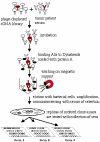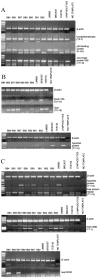Identification of a panel of tumor-associated antigens from breast carcinoma cell lines, solid tumors and testis cDNA libraries displayed on lambda phage
- PMID: 15541172
- PMCID: PMC539249
- DOI: 10.1186/1471-2407-4-78
Identification of a panel of tumor-associated antigens from breast carcinoma cell lines, solid tumors and testis cDNA libraries displayed on lambda phage
Abstract
Background: Tumor-associated antigens recognized by humoral effectors of the immune system are a very attractive target for human cancer diagnostics and therapy. Recent advances in molecular techniques have led to molecular definition of immunogenic tumor proteins based on their reactivity with autologous patient sera (SEREX).
Methods: Several high complexity phage-displayed cDNA libraries from breast carcinomas, human testis and breast carcinoma cell lines MCF-7, MDA-MB-468 were constructed. The cDNAs were expressed in the libraries as fusion to bacteriophage lambda protein D. Lambda-displayed libraries were efficiently screened with sera from patients with breast cancer.
Results: A panel of 21 clones representing 18 different antigens, including eight proteins of unknown function, was identified. Three of these antigens (T7-1, T11-3 and T11-9) were found to be overexpressed in tumors as compared to normal breast. A serological analysis of the 21 different antigens revealed a strong cancer-related profile for at least five clones (T6-2, T6-7, T7-1, T9-21 and T9-27).
Conclusions: Preliminary results indicate that patient serum reactivity against five of the antigens is associated with tumor disease. The novel T7-1 antigen, which is overexpressed in breast tumors and recognized specifically by breast cancer patient sera, is potentially useful in cancer diagnosis.
Figures





References
-
- Lake DF, Huynh WC, Hersh EM. Natural and induced human antibody response to cancer. Cancer investigation. 2000;18:480–489. - PubMed
-
- Hansen MH, Ostenstad B, Sioud M. Identification of immunogenic antigens using a phage-displayed cDNA library from an invasive ductal breast carcinoma tumor. Int J Oncol. 2001;19:1303–1309. - PubMed
-
- Somers VA, Brandwijk RJ, Joosten B, Moerkerk PT, Arends J-W, Menheere P, Pieterse WO, Claessen A, Scheper RJ, Hoogenboom HR, Hufton SE. A panel of candidate tumor antigens in colorectal cancer revealed by the serological selection of a phage displayed cDNA expression library. J Immunol. 2002;169:2772–2780. - PubMed
MeSH terms
Substances
LinkOut - more resources
Full Text Sources
Other Literature Sources
Medical
Miscellaneous

